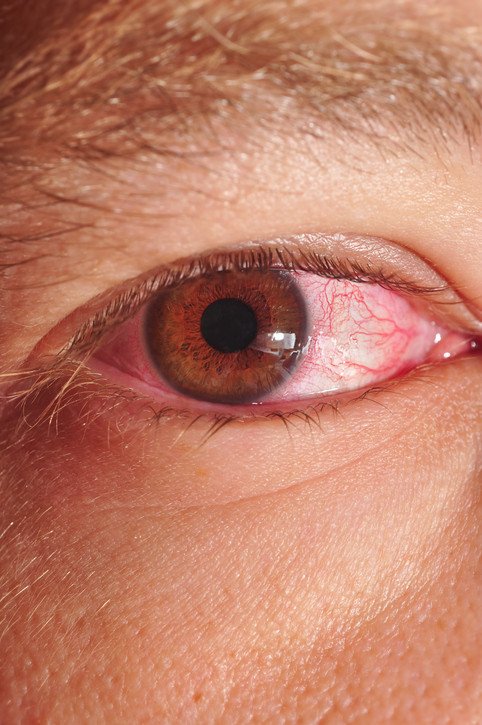Pink eye (conjunctivitis)
Medically reviewed by Drugs.com. Last updated on Sep 17, 2024.
What is conjunctivitis?

Conjunctivitis, also called pink eye, is an inflammation of the conjunctiva, the transparent membrane that lines the eyelids and covers the whites of the eyes. Conjunctivitis can be triggered by allergies, by contact with irritating chemicals, or by infections with either a virus or bacteria.

Image: dtimiraos/Getty Images
- Viral conjunctivitis often is caused by one of the adenoviruses, a family of viruses that usually causes colds (upper respiratory illnesses). In temperate climates, adenoviruses are most active during spring, early summer and mid-winter. They infect fluids in the eyes, mouth and nose, and can spread from person to person on hands and in the droplets of coughs and sneezes. In most cases, adenoviruses cause only a mild case of conjunctivitis. However, they are capable of causing a more serious infection, called kerato-conjunctivitis, which can cloud the cornea and interfere with vision. Besides adenoviruses, other viruses that cause conjunctivitis include enteroviruses, the measles virus (rubeola) and the herpes simplex virus.
- Bacterial conjunctivitis can be caused by several different types of bacteria, including Haemophilus influenzae, pneumococci, staphylococci (staph) and streptococci (strep). Most bacterial infections spread through contact with hands that have been contaminated with the bacteria. Children born to mothers with gonorrhea or chlamydia also can develop conjunctivitis if their eyes are infected by contaminated secretions in the birth canal during vaginal delivery.
Symptoms of conjunctivitis
Symptoms of conjunctivitis include:
- red, watery eyes
- eye discomfort (feeling itchy or scratchy)
- a discharge from the eyes that may form crusts around the eyelashes.
If it's viral conjunctivitis, this eye discharge tends to be thin, clear and watery. The eye discharge from bacterial conjunctivitis it is often thick, discolored (yellow or greenish), cloudy and sticky. Sometimes, the discharge is so sticky that the eyelids stick to one another. This is most likely to happen after waking up from sleep. With allergic conjunctivitis, both eyes usually are involved, itching is more intense and the eyes may swell.
If you wear contact lenses, you are more likely to develop severe conjunctivitis, which can damage the eye. Stop wearing contact lenses if you develop a red eye. Contact your primary care doctor or an eye doctor immediately if you have any pain.
Diagnosing conjunctivitis
Your doctor will suspect conjunctivitis if you have an itchy, red eye with a discharge or increased tearing. If your doctor suspects bacterial conjunctivitis, he or she may take a sample of your eye discharge and send it to a laboratory to be tested.
Expected duration of conjunctivitis
Even without treatment, most cases of viral conjunctivitis will go away within seven days.
Bacterial conjunctivitis requires antibiotics. Eye redness usually begins to clear up within a couple of days after you start taking antibiotics. Make sure you take all your antibiotics, even if you start to feel better. Otherwise the medicine may not kill all the bacteria.
Preventing conjunctivitis
It is possible to prevent infectious conjunctivitis. Wash your hands frequently and avoid touching your eyes. At home, never share towels, washcloths or facial cosmetics with others, especially eye makeup.
To prevent conjunctivitis in newborn babies, all pregnant women should be tested and, if necessary, treated for gonorrhea and chlamydia infections. As another preventive measure, newborns routinely are treated at birth with antibiotic eye drops.
Drugs used to treat this and similar conditions
Treatment options
The following list of medications are related to or used in the treatment of this condition.
Treating conjunctivitis
For uncomplicated viral conjunctivitis, your doctor may suggest nonprescription eye drops, which relieve eye symptoms while your body fights off the viral infection.
For bacterial conjunctivitis, you'll need prescription ointment or eye drops containing antibiotics. Use these for as many days as your doctor tells you, even if your symptoms clear up within a day or two. You also can apply warm compresses, such a washcloth, to your eyes for 20- to 30-minute periods, several times a day. Gently wipe away eye discharge and dry, crusty material with a clean, moist cotton ball or tissue.
For allergic conjunctivitis, antihistamine eye drops and cool compresses can help to relieve itching.
Newborns that develop gonorrheal or chlamydial conjunctivitis are treated with antibiotics that can be put on the eye, taken by mouth or injected into a vein, depending on the severity. Their mothers should be examined and treated for gonorrhea or chlamydia infections.
When to call a professional
Call your doctor if your eyes become red, watery and itchy, especially if there is a thick eye discharge that crusts on your eyelids. Call your doctor immediately if you have pain or swelling in your eyes, or if you develop blurred vision or a high fever or become sensitive to light. Call your doctor immediately whenever an infant, especially a newborn, shows symptoms of conjunctivitis.
If you are taking antibiotics to treat bacterial conjunctivitis, call your doctor if your eye redness continues after three days.
Prognosis
Most cases of uncomplicated viral or bacterial conjunctivitis get better without causing permanent eye damage.
Additional info
National Eye Institute
https://www.nei.nih.gov
American Academy of Ophthalmology
https://www.aao.org
Learn more about Pink eye
Treatment options
Care guides
Further information
Always consult your healthcare provider to ensure the information displayed on this page applies to your personal circumstances.
